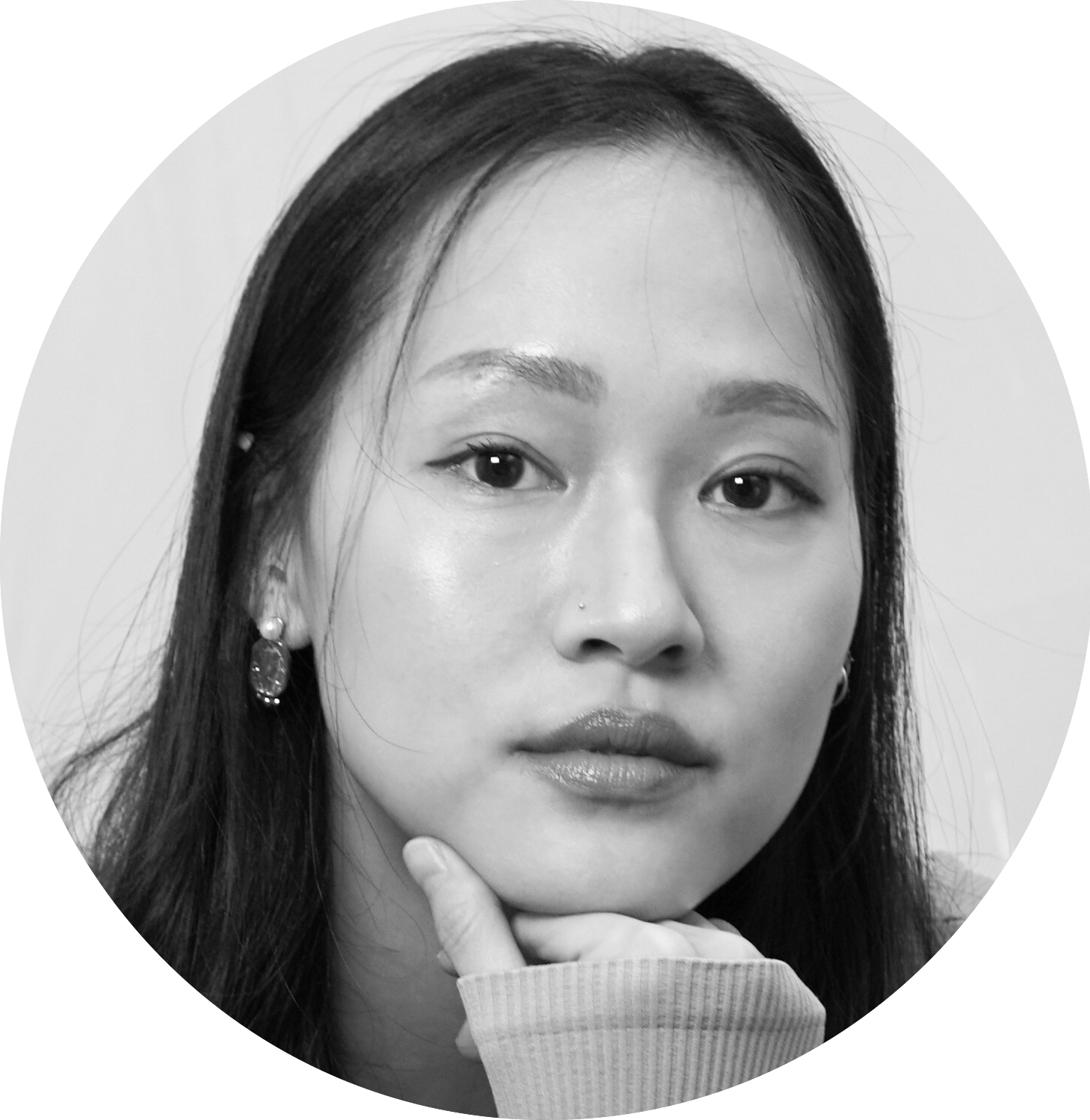
Angelene Wong is a doctoral candidate at the School of Art, Design and Media at Nanyang Technological University. She holds an MA in Fashion Studies from Parsons, The New School (2019). Additionally, she lectures part-time at the School of Fashion at Lasalle College of the Arts and co-authored Fashion, Identity, Image (Bloomsbury, 2022).
The history of the fashion modeling industry in Singapore demonstrates how modernity was negotiated through the performances of fashion models, who embodied the aspirations of the masses in the fashion pages of magazines. In this article, I take on two tasks: first, to trace the development of the fashion modeling industry in Singapore, and second, to understand how posing techniques allowed models to perform modernity. I focus on the period from 1970 to 1979, when the emergence of the “cool” persona of the Singaporean fashion model presented a stark contrast from those in the magazine pages of the 1960s and that continued to influence fashionable ideals in the 1980s. The coolness of Singapore’s fashion model permeated feminine ideals not just in appearance and attitude but in relationships and work. Most importantly, it presents the eagerness to appear modern.
This article’s argument is part of my doctoral thesis that addresses the same topic but with the expanded timeframe of the 1960s to 1980s. It acts on the burgeoning interest in Singaporean fashion history and the methodological potential of studying the fashioned body through performative research. The research contributes to the field of Singaporean fashion history that has emerged in recent years because of initiatives by the National Heritage Board, National Library Singapore, the Asian Civilisations Museum, LASALLE College of the Arts, and a small collective of scholars across Singapore’s universities who have taken up the project of documenting and studying this history.
In the 1970s, Singapore was negotiating its national identity in relation to British colonial rule (1946-1958) and its independence from Malaysia (1965). Singapore's successful consolidation of its national identity since 1965, surpassing other colonial states in economic growth, demonstrates a unique postcolonialism. Unlike many former colonies, Singapore's developmental nationalism aligned closely with its former colonial power, the United Kingdom. [1] Fashion, as Djurdja Bartlett suggests, transcends national boundaries, particularly in the context of the rise of transnational fashion amid the formation of nation-states. [2] Fashion models and their poses reveal the cultural negotiation of postcolonial, national, and feminine ideals. Their bodily sensibilities performed in fashion spreads were the somatic navigation of multiple gazes—Oriental, male, and commodifying—frozen in the pages of the institutional apparatus of magazines that functioned to re-imagine good taste and mobilize a nation towards an emerging modern identity.
Through reading lifestyle magazines and newspapers archived at the National Library Singapore, I write about the development of the Singaporean fashion modeling industry during the 1970s. [3] In tandem, I analyze the poses in select fashion images through what I term ‘somatic mimesis,’ where I learn the fashion models’ poses to understand how meaning is encoded and constructed on their bodies. This meaning intertwines national and feminine ideals. I developed the method of somatic mimesis through reading decolonial and feminist scholars who argue that the body, which has historically been silenced in scholarship, should be reclaimed as a legitimate source of knowledge. [4] While I have elaborated on this experimental embodied methodology in a forthcoming chapter elsewhere, this article centers on the thematic findings of the analysis that characterized Singapore’s fashion models in the 1970s, particularly exploring the concept of performing coolness. My research is interested in the posing techniques behind the performance of modernity in the archive. These techniques can be accessed through deep analysis of the embodied performances of the models by embodying the poses myself. Therefore, besides reading and visually analyzing the images, I employ an embodied performative practice as part of this process of thinking through images. [5]
The photographs I include here are the result of a photoshoot wherein I chose fashion images from the Singaporean lifestyle magazines Her World and Female and imitated them. The fashion images served as a choreographic score for me to learn and practice embodying the poses that represented the feminine ideals of the times. The style of the images is by design—my outfit of a black leotard against the bare background serves to decontexutalize and de-individualize the poses, to spotlight just the poses. Furthermore, I mainly use my own images here instead of the archival fashion magazine images as a solution to the difficulties of publishing the latter. [6]
This article’s argument is part of my doctoral thesis that addresses the same topic but with the expanded timeframe of the 1960s to 1980s. It acts on the burgeoning interest in Singaporean fashion history and the methodological potential of studying the fashioned body through performative research. The research contributes to the field of Singaporean fashion history that has emerged in recent years because of initiatives by the National Heritage Board, National Library Singapore, the Asian Civilisations Museum, LASALLE College of the Arts, and a small collective of scholars across Singapore’s universities who have taken up the project of documenting and studying this history.
In the 1970s, Singapore was negotiating its national identity in relation to British colonial rule (1946-1958) and its independence from Malaysia (1965). Singapore's successful consolidation of its national identity since 1965, surpassing other colonial states in economic growth, demonstrates a unique postcolonialism. Unlike many former colonies, Singapore's developmental nationalism aligned closely with its former colonial power, the United Kingdom. [1] Fashion, as Djurdja Bartlett suggests, transcends national boundaries, particularly in the context of the rise of transnational fashion amid the formation of nation-states. [2] Fashion models and their poses reveal the cultural negotiation of postcolonial, national, and feminine ideals. Their bodily sensibilities performed in fashion spreads were the somatic navigation of multiple gazes—Oriental, male, and commodifying—frozen in the pages of the institutional apparatus of magazines that functioned to re-imagine good taste and mobilize a nation towards an emerging modern identity.
Through reading lifestyle magazines and newspapers archived at the National Library Singapore, I write about the development of the Singaporean fashion modeling industry during the 1970s. [3] In tandem, I analyze the poses in select fashion images through what I term ‘somatic mimesis,’ where I learn the fashion models’ poses to understand how meaning is encoded and constructed on their bodies. This meaning intertwines national and feminine ideals. I developed the method of somatic mimesis through reading decolonial and feminist scholars who argue that the body, which has historically been silenced in scholarship, should be reclaimed as a legitimate source of knowledge. [4] While I have elaborated on this experimental embodied methodology in a forthcoming chapter elsewhere, this article centers on the thematic findings of the analysis that characterized Singapore’s fashion models in the 1970s, particularly exploring the concept of performing coolness. My research is interested in the posing techniques behind the performance of modernity in the archive. These techniques can be accessed through deep analysis of the embodied performances of the models by embodying the poses myself. Therefore, besides reading and visually analyzing the images, I employ an embodied performative practice as part of this process of thinking through images. [5]
The photographs I include here are the result of a photoshoot wherein I chose fashion images from the Singaporean lifestyle magazines Her World and Female and imitated them. The fashion images served as a choreographic score for me to learn and practice embodying the poses that represented the feminine ideals of the times. The style of the images is by design—my outfit of a black leotard against the bare background serves to decontexutalize and de-individualize the poses, to spotlight just the poses. Furthermore, I mainly use my own images here instead of the archival fashion magazine images as a solution to the difficulties of publishing the latter. [6]
Singapore’s fashion scene and modeling industry in the 1970s
In the 1970s, Singapore saw a surge in fashion consciousness alongside greater discourse on feminism through the Women’s Liberation Movement. The discourse on womanhood intensified with the introduction of the Women’s Charter, which offered Singaporean women unique rights such as retaining their maiden names and independent taxation. However, only 2 percent of Singaporean women earned SGD1,500 or more per month, and there were no female parliamentarians. [7] Despite nominal empowerment, women faced limitations in professional advancement and equitable access to high-paying jobs. Journalist Rebecca Chua observed that women's pay and education lagged behind men's, with women primarily occupying roles in industrial, nursing, and teaching sectors. Managerial opportunities for women were scarce, and governmental support for women in parliament was lacking. Chua thus concluded that women were more depoliticized in the 1970s than in the past, having absorbed traditional gender roles such as beautification and devotion to family, which she blamed in part on magazines. [8] This set the tone for this transitionary period that brought juxtaposing viewpoints on women’s conduct in society and changing gender norms.
Not only was 1975 the year when The United Nations declared the International Women’s Year, it was also when Christian Dior showed a collection in Singapore for the first time. [9] In addition to greater awareness of luxury fashion, fashion in general became more accessible to the masses as the Western fashion industry shifted from haute couture to ready-to-wear. [10] Ruth Warner, a pioneering figure in Singapore’s modeling agency world, reflected in 1976 that there were many more fashion stores in Singapore in 1956, the year she started a modeling school. She wrote, “The model business has blossomed in the past few years. It has actually become possible for a model in Singapore to earn a decent living” with “a solid core of girls capable of earning a steady $1,000 per month [...] a respectable sum compared with salaries for nurses and secretaries.” [11] The high-earning models including Carrie Wong, who worked in Hong Kong before arriving in Singapore in 1972, could demand SGD1,500 per month in 1973. [12] Carrie’s work was wide-ranging—house modeling, runway shows, photographic modeling, and appearances in newspapers, calendars, and on television.
There was also a higher circulation of fashion-related magazines such as Mode Indonesia, an Indonesian magazine catering to the “new woman” that was first published in July 1975, Femina, an Indian magazine that sold about 3000 copies in Singapore and Malaysia per month in 1975, Her World, Female, and Go. [13] Fashion shows became more frequent, hosted by hotels showcasing both local and foreign designers. The influx of Japanese department stores and more designer boutiques in Singapore catered to a clientele desiring European fashions. European labels became a symbol of modernity for Singaporean women, particularly evident in high-society events. [14] Fashion in Singapore served as both a national project and a means for individuals, especially women, to “negotiate their position, drawing on fashion’s cosmopolitanism to disturb nationalist, conservative and religious accounts,” and also to partake in international fashion culture. [15] The circulation of fashion images and shows fueled an increased investment in appearance and discussions on grooming standards.
Models—more local ones as compared to previous decades—became valorized figures as they found success locally and overseas. The increased popularity of fashion modeling in Singapore follows the trajectory that Ashley Mears documents, wherein, the 1970s UK saw a “creative revolution” that ushered in an era of “‘image-led’ or ‘aspirational’ advertising” aimed at cultivating an emotional connection between consumers and products through the fashion model. [16] Modeling and grooming courses and modeling competitions hosted by Her World and Female became commonplace, giving women new professional possibilities and the chance to travel out of Singapore. Female’s “Model Discovery ‘76” promised to fly their winner on Thai Airways International to Sydney to be groomed by the June Dally-Watkins Modelling School and SGD1,000’s worth of contracts. [17] International contracts were awarded to Singapore-based models such as Carrie Wong, who won a contract to be a house model for Emilio Pucci in Florence in 1974, and other models from modeling agency Mannequin Studio who were touring Asia. [18] By 1978, modeling was an esteemed career for women leaving school. [19] The beauty queen, the air hostess (more popularly known as the Singapore Girl), and fashion models thus held similar prestige and represented feminine ideals of the era, while simultaneously building the reputation of Singapore’s national brand.
A hierarchy of Singaporean models began to be solidified in the mainstream media, setting up criteria for what it meant to be a successful Singaporean model both in their looks and in their professional achievements. In 1978, Her World announced its nominees for “Top Models of the Year 1977,” Carrie Wong, Tina Tan, Theresa Lau, Jean Ho, and Jane Lim. These models were chosen based on having been nominated by their agencies for their volume of work in the media and on runways, and their paychecks. [20] Throughout 1979, Her World published a series called, “The Grooming of a Superstar Model,” which followed the magazine’s journey in a modeling course in conjunction with Imp International, a modeling agency, conducted by Maxine Howell Price. It covered what the model-trainees learned, including diet, skincare, hair styling and care, how to style oneself, posing, the catwalk, acting, and social etiquette that emphasized allowing men to be chivalrous. The modeling industry was increasingly regimented and regulated by the fashion media.
Yet, the stigma against modeling was not all dismantled. It was reported that low rates and the profession’s perceived lack of prestige and longevity led to a shortage of “good” models. Furthermore, there was some bias against Singaporean models who were deemed less receptive to new fashions or less capable compared to their European and Japanese counterparts. [21] There was also the risk of overexposure for successful models. On this note, Warner advised aspiring models to equip themselves with other skills for professional lives beyond modeling. [22] This period marked a transitional phase preceding the 1980s, during which the phenomenon of the supermodel ascended to prominence.
Singaporean models, celebrated for their ‘exotic’ looks, embodied the hybridity of—and the chasm between—locality and globality. Mei-Ling Chan was called the “Singapore-girl-who-made-good” because she first modeled for Her World before going to Hong Kong to further her career and eventually traveled around Europe, working as a professional model since 1962. [23] She came back to Singapore for the “Triumph ‘70” show after being recruited to model in Switzerland. She was described as “Attractive, very Oriental, not strictly beautiful.” [24] Similar to Mei-Ling, Carrie Wong was lauded for her look that combined exotic Easternness and fashionable Westernness: “Carrie is the essence of Oriental mystic and Western chic.” [25] Exoticism was a desired aesthetic trait in Asian models, demonstrating how despite their local and international success, these models were still viewed through an Orientalist lens. This chasm was expressed by US model Sandra Heidenreich, who came to Singapore and worked at the Joan Booty Modelling Academy in 1974. She claimed that “her ‘mission’ is ‘to project international trends on the local scene’” and that, “The cosmopolitan charm of your people and culture has an irresistible attraction for me.” [26] Her claim to internationalism and her reference to the attractiveness of the Singaporean people’s “charm” reproduces global hierarchies, the West’s claim to universalism, and images of the exotic East, and these are perpetuated through the Singaporean media. The appraisals of Singaporean women by their Euro-American counterparts and the further pleasure taken in these appraisals by local journalists demonstrate the internalization of colonial attitudes.
Orientalism was both maintained and challenged. The “oriental look” was not only sought after in models but was also romanticized and sold as make-up looks. [27] This is evident in the article, “Making Faces,” which presents make-up looks inspired by the Orient, and according to Carrie Wong who said that the Chinese make-up look was very popular in Paris and Rome in 1974. [28] The self-Orientalization on the part of the Singaporean media demonstrates a complex process of self-identification filtered through lenses of coloniality and globalization. Not only did Singaporeans see themselves through the eyes of Euro-America during a time of economic vulnerability, but through fashion practices and journalism, they continued to reproduce this hierarchy.
Cosmopolitanism in Singapore takes on a complex character that fuses multiple sources of influence including the Oriental and the colonial. In terms of fashion, what was happening in Singapore arguably conforms to what Regev (2007) calls “aesthetic cosmopolitanism” where cultural expression and influence are multi-directional and transcend a typical dominant-submissive hierarchy between cultures. Regev explains, “It is rather, a practically unavoidable consequence of late modernity, of the genuine interest of groupings around the world to join and participate in scenarios of ‘good life’ disseminated from the metropolitan centers and through their prism.” [29] Aesthetic cosmopolitanism here responds to how postcolonial cultures adapt and fuse cultural influences through their own creativity and agency. It is difficult, then, to identify a singular “Singaporean culture” when it is formed through such postmodern mixing. This mixing includes explorations of postcolonial identities that may retain some tropes of colonialism and Orientalism.
The concept of “cosmopolitan charm” here becomes a useful framework to think about the contradictions that arise in the expressions of modern Singaporean identity by fashion models. The concept of “charm” is furthermore useful to my analysis of models because, beyond its reference to an attractive and often elusive quality, it also has an industrial meaning. Charm schools introduced in Singapore in the 1950s where social etiquette and comportment were taught, were the precursors to the more formalized modeling agencies and schools later on. Charm is thus constructed through socially agreed codes of conduct and performance in everyday life, which can be taught and practiced.
Coolness as “cosmopolitan charm”
In the 1970s, the “cool girl” emerged to the forefront of modeling. Her rebellious attitude translated into a liberated posing style in fashion images that re-imagined the woman’s place in professional and public realms, as well as placed a heightened emphasis on courtship. She was the face of modern Singapore against the backdrop of a bygone pre-industrial era — her modernity was established based on her difference from Singapore’s past, producing nostalgic images that enabled the models to appear fresh and confident in a new age.
Coolness is the performance of emotional restraint and has been traced to several sources. Peter Stearns defines cool as such: “Being a cool character means conveying an air of disengagement, of nonchalance, and using the word is part of the process of creating the right impression.” [30] He argues that coolness, beginning from the Victorian era, was revived by the mid-twentieth century American middle-class in their “preoccupation with dispassion” to make characteristics of white anxiety, such as nihilism and detachment, desirable. [31] Other scholars have traced the beginnings of cool as an expression of emotional suppression and resistance by marginalized groups, including countercultures, subcultures, and those discriminated against for racial, religious, and sexual reasons. [32] Coolness was also a global trend popularized through Hollywood actors such as John Travolta and Harrison Ford in the 1970s, leading the trend of youthful aloofness.
Considering the postcolonial status of Singapore in the 1970s and the eagerness to establish its economic capital as a means of survival, one may argue that the disposition of coolness becomes a handy tool for a nation to perform modernity and its cultural capital. In effect, it drives economic growth through consumption and tourism. As Belk et al. argue, “Cool is a way of substituting a particular cultural capital for economic capital, although, with the commodification of cool, we shall see that economic capital is also increasingly needed.” [33] Cool for Singaporean models can be defined as the performance of nonchalance towards rapid modernization, as if one already belonged in the future. Coolness differs from the controlled poise of sophistication and exuberant playfulness of the 1960s, substituting them for emotional restraint in an act of effortlessness. This attitude is captured in fashion images and circulated to a mainstream Singaporean female readership to inculcate what aspirational femininity in modern Singapore should look like. In the performance of coolness by Singaporean models, we see how coolness is constructed on bodies and commodified through the fashion media towards a broader re-imagining of a city eager to succeed.
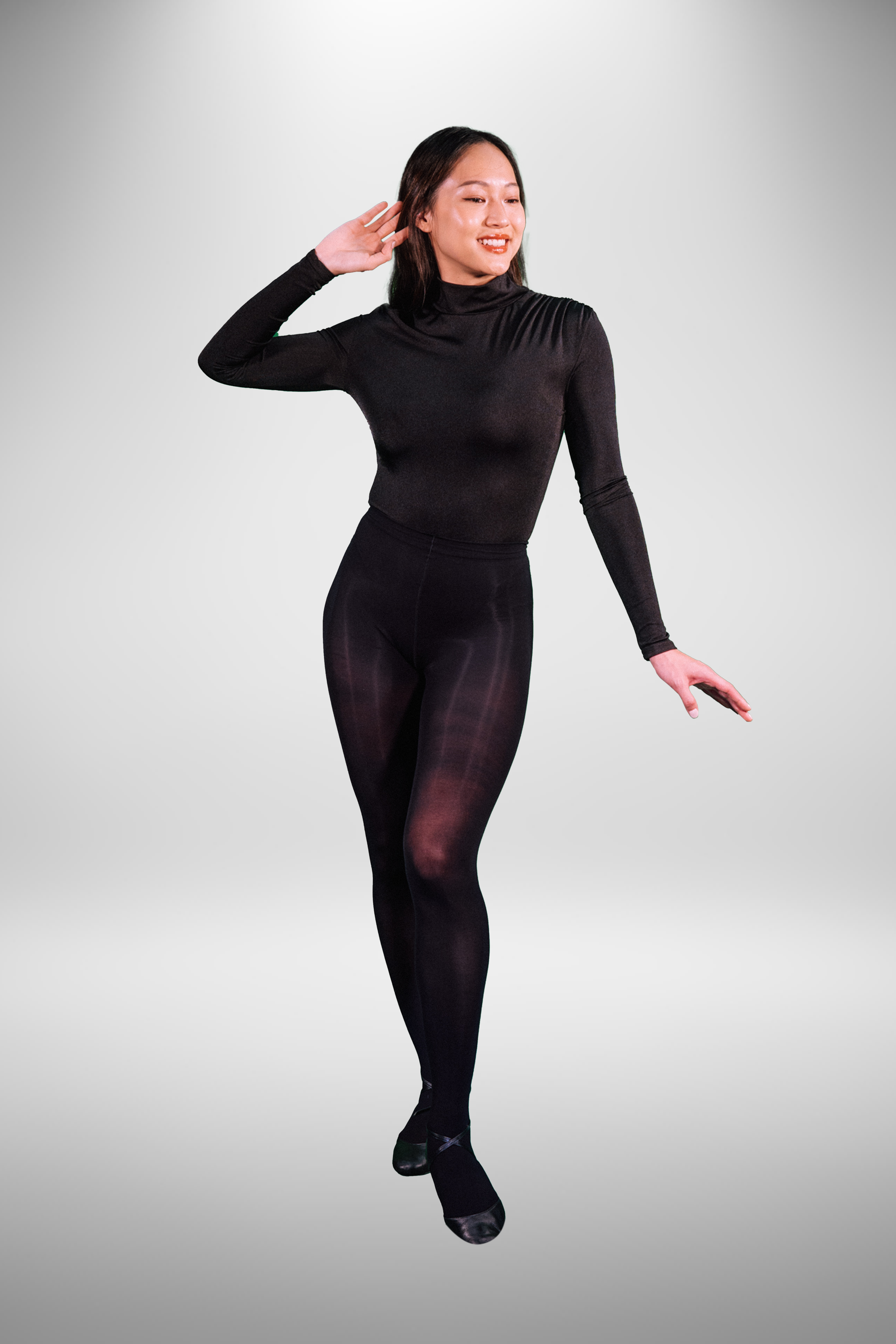
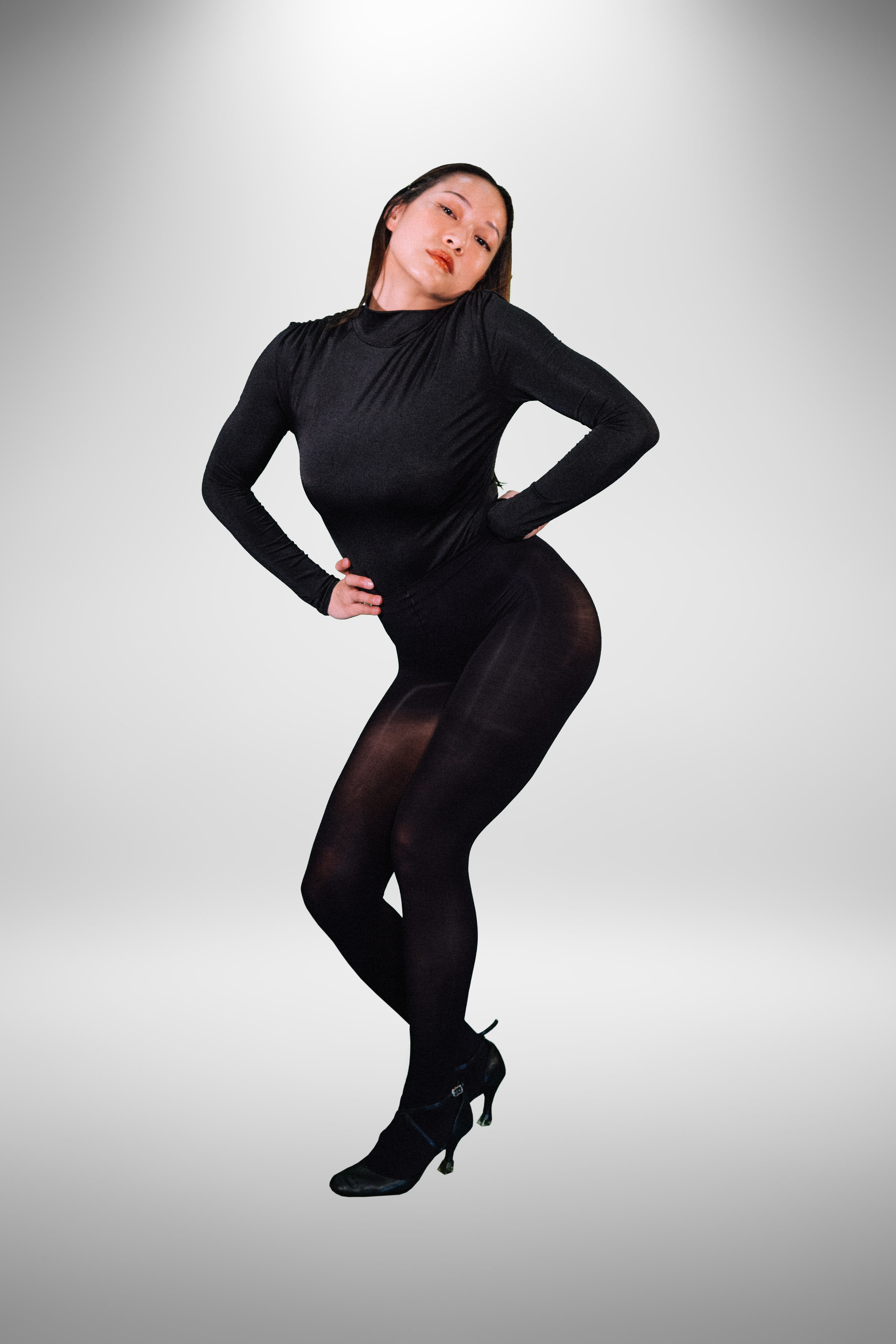
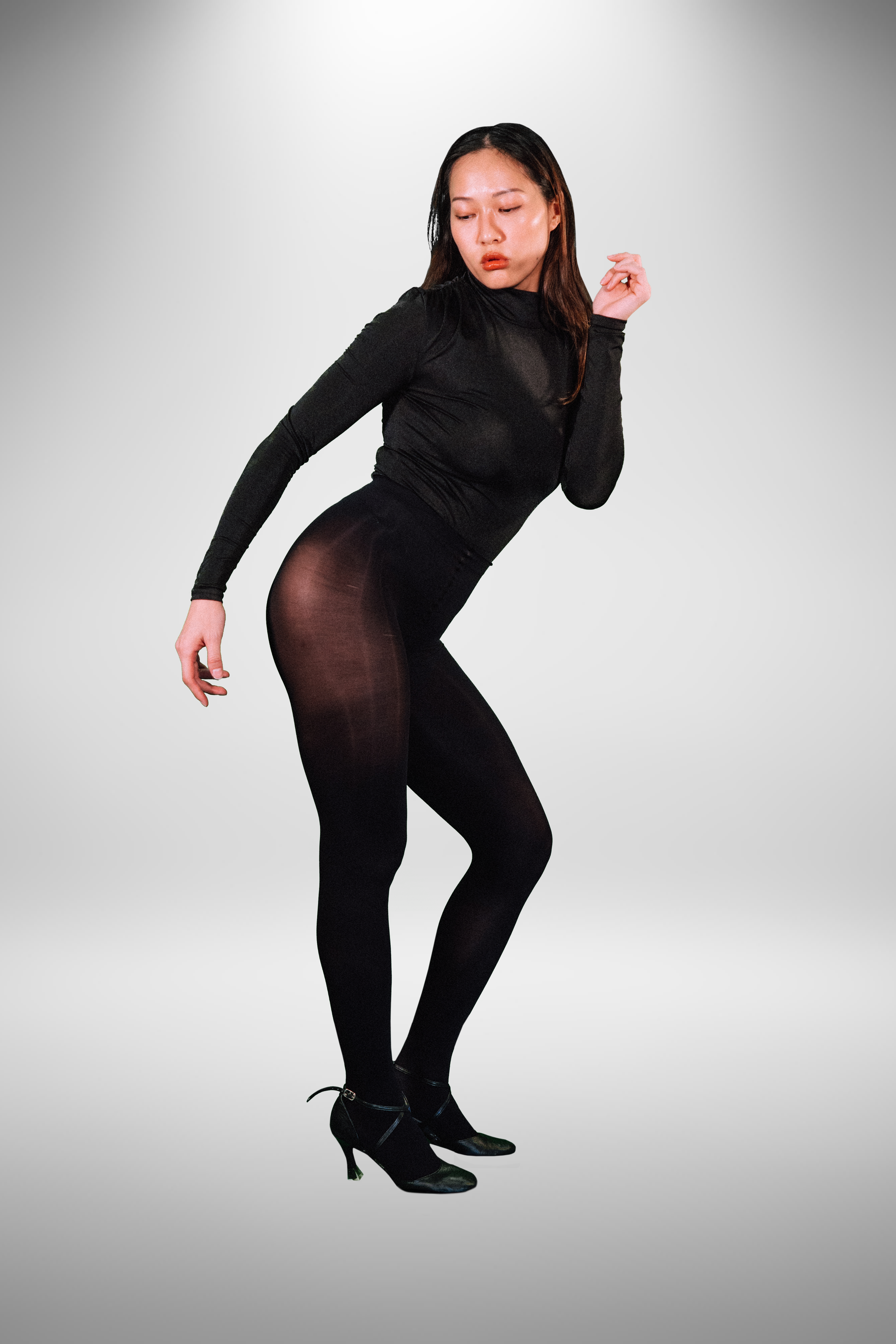 Top: Figure 1: Mimesis of a representative pose of the mid-1960s by Vicki Dutton in “FASHION FLING: That Million-Dollar Look,” Her World, August 1965, 11.
Top: Figure 1: Mimesis of a representative pose of the mid-1960s by Vicki Dutton in “FASHION FLING: That Million-Dollar Look,” Her World, August 1965, 11. Middle: Figure 2: Mimesis of the pose by Mei-Ling Chan in a fashion spread, “WINNER SPINNERS,” Her World, November 1972, 53.
Bottom: Figure 3: Mimesis of a pose from a fashion spread in Her World, “Beautiful Clothes For Beautiful People,” March 1974, 11.
All images courtesy of the author.
“The new Singaporean woman was ambitious and invested in her career. The many fashion spreads that featured models play-acting in various career roles evince this point.”
Unlike the 1960s when propriety and pleasantness dominated the posing standards (Figure 1), the cool girl of the 1970s emerged with a daring attitude. The cool girl’s aloofness and defiance had an undertone of playfulness that permeated her style in occupying both professional and interpersonal roles. We see this sense of coolness with model Mei-Ling Chan who featured in Her World’s spread in November 1972 (Figure 2). The spread encourages its readers to be adventurous in their choice of party clothes by simply adopting the right “attitude.” This attitude is embodied by Mei-Ling whose pose exudes nonchalance and defiance. She wears an unsmiling face, with bored eyes and an upturned chin. I mimicked her by contorting my body, sitting exaggeratedly into one hip to accentuate the curve of my back. Similarly, a pose from Her World March 1974 (Figure 3) demonstrates a change in the ideal line of the body, from sinuous to emphasizing an arched back. To achieve this pose, I hinged my body forward to push one hip outwards in an arched position. The pose appears mid-movement, with one arm extended parallel to the back and the other bent at the elbow in front of the chest. Like the model, I cast a downward gaze toward the protruding hip and wore a coquettish yet aloof expression with pursed lips. These two poses mark the shift in bodily ideals and self-presentation from the 1960s, from subtlety to provocation.
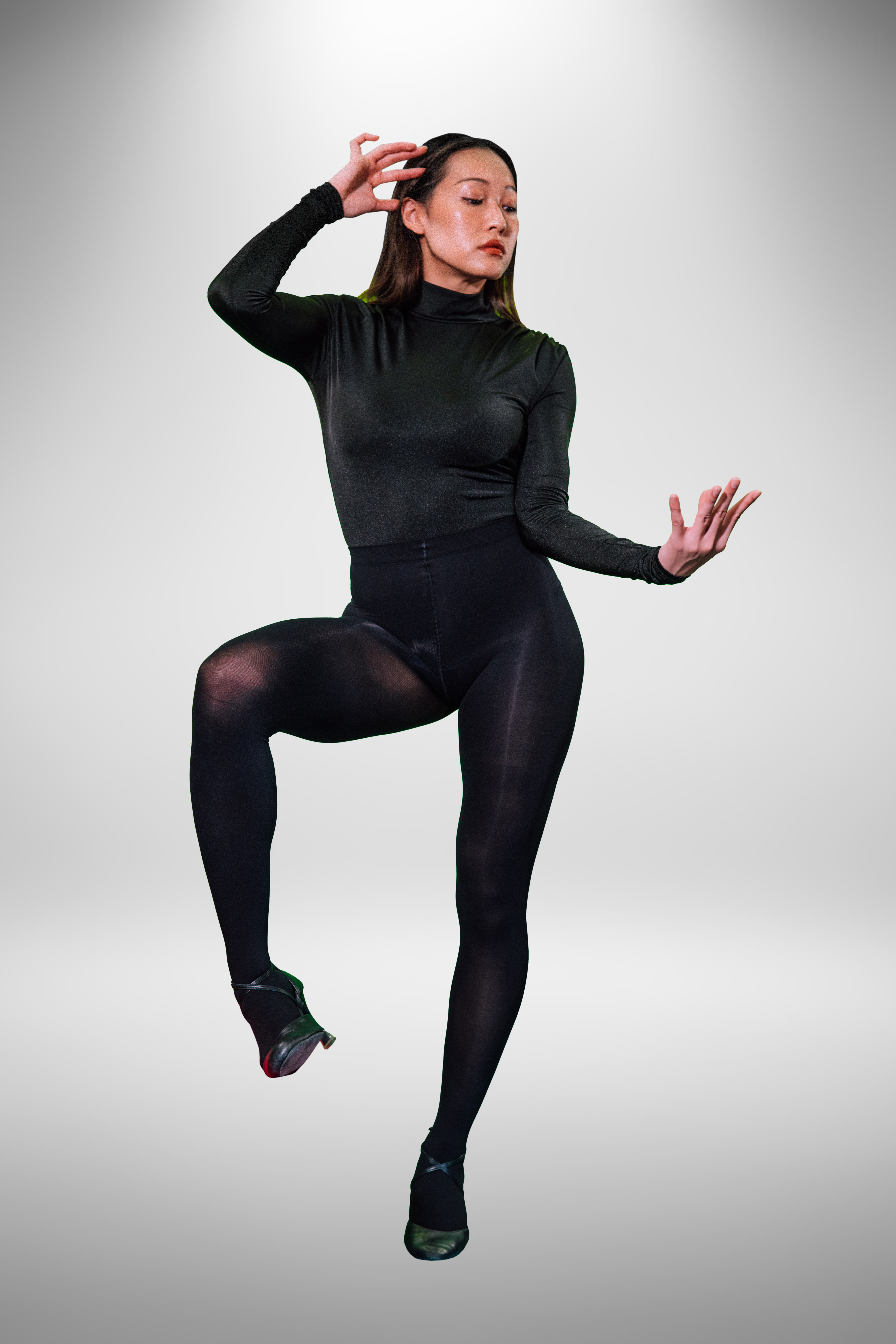
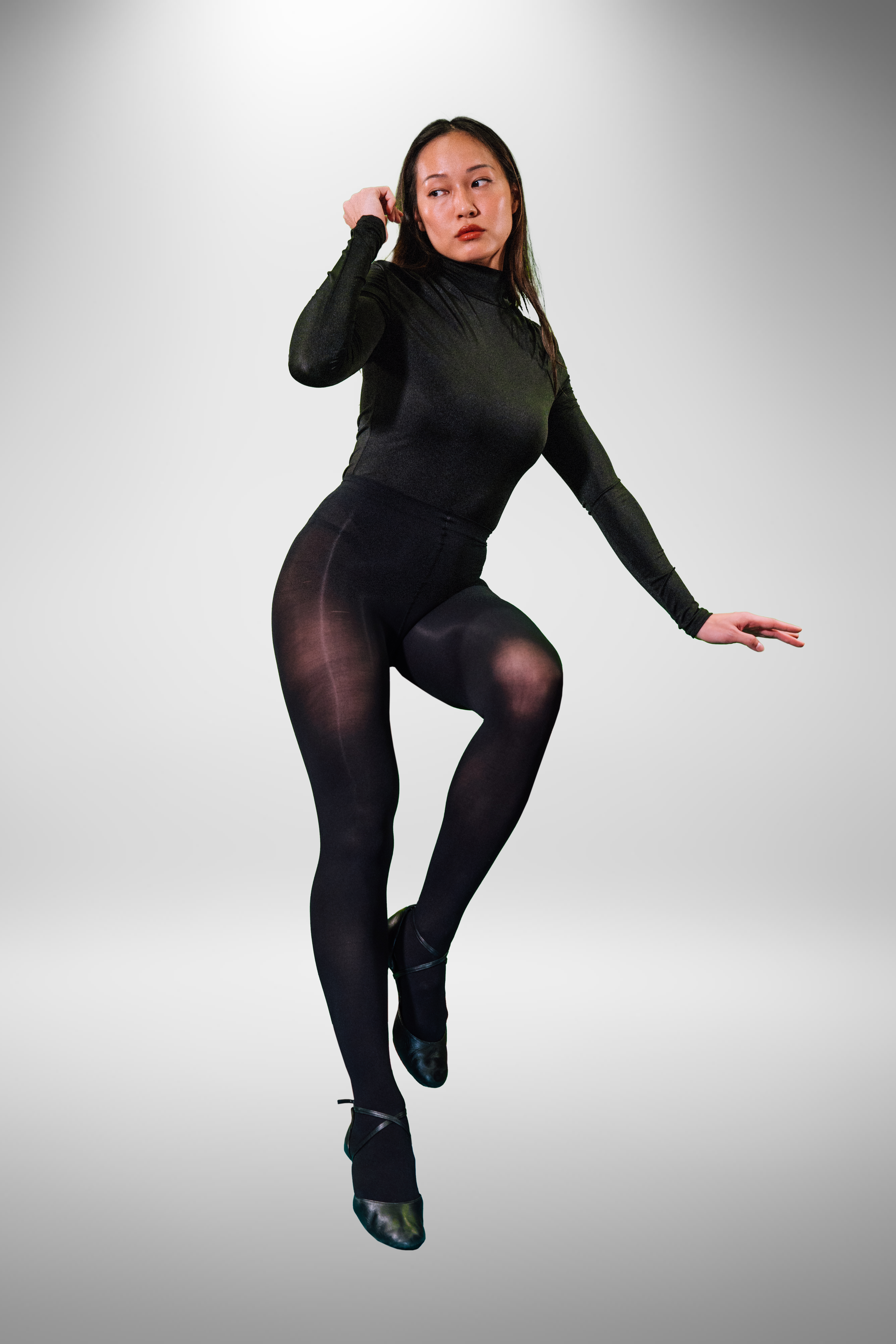 Top: Figure 4: Mimesis of a pose by model Angie in a fashion spread, “CHIC ECONOMY,” in Female, June 16, 1975, 44-45.
Top: Figure 4: Mimesis of a pose by model Angie in a fashion spread, “CHIC ECONOMY,” in Female, June 16, 1975, 44-45.Middle: Figure 5: Mimesis of a pose by model Carrie Wong in a fashion spread, “VERY SPECIAL ADAPTABLES,” in Female, January 1, 1976, 45.
All images courtesy of the author.
The new Singaporean woman was ambitious and invested in her career. The many fashion spreads that featured models play-acting in various career roles evince this point. Coolness is a characteristic of the working woman later into the 1970s just as the characters become more reflective of the real lives of Singaporean women. In a spread in Female, June 16, 1975, titled “CHIC ECONOMY” (Figure 4) and in Female, January 1, 1976, titled “Very Special Adaptables” (Figure 5) we see the emphasis on height given the low camera angle that allows for exaggeratedly long legs. The models in “Chic Economy,” Angie and Carol, appear engaged in work in a printing room where they choose colors and check printed copies of magazines. Angie, whose pose I re-enact, creates a more angular shape by lifting her arm and placing her fingertips lightly on the side of her head. The two women are more preoccupied with their work than with the camera. In “VERY SPECIAL ADAPTABLES,” two models including Carrie Wong are seen in an office answering an important call from the office telephone. They appear at home in a professional environment; not so much posed, but more like mid-movement or mid-conversation. Carrie, whose pose I imitated, encompasses her half-sitting on an office table. She leans her weight towards the table in a way that creates an exaggerated hip-to-waist line, finished with a pointed right toe that lengthens the leg line. She holds the telephone to her ear and looks over to her right — her downcast eyes and pursed lips lend a haughty expression. Again, we can observe how the sense of defiance of the cool girl translates into confidence in the corporate environment.
![]() Figure 6: Mimesis of a pose from a fashion spread, “Harlequins, Holly and Hanky-Panky,” in Her World, December 1976, 66.
Figure 6: Mimesis of a pose from a fashion spread, “Harlequins, Holly and Hanky-Panky,” in Her World, December 1976, 66.
Even though the Singaporean woman was more visible in the professional realm, she was also expected to be actively engaged in courtship and romance. [34] The performance of more suggestive poses (Figures 2 and 3) demonstrated an increased sexualization of the female body. This was complemented by an increased frequency of posing with men in the fashion pages, role-playing courtship. This demonstrates how it was becoming the fashionable ideal to be openly dating or engaged in heterosexual relations. These women were seen to be taking charge of their romantic relationships. For example, in the June 1976 issue of Her World, Carrie is pictured emerging from a car escorted by her male companion. In the August 1976 issue of Female, Carrie poses with her male counterpart as if they are dancing. Other examples include a party-themed fashion spread in Her World, December 1976, where the model appears to be flirting with her suitor, and similarly, in another spread in the September 1, 1979 issue of Female, the models hold hands and embrace their male companions as they gallivant through the city. When posing with a partner, the female models’ interaction with the male models affected how they each posed. Nonetheless, the female model remains the center of attention and the male model becomes her accessory as a fashionable woman.
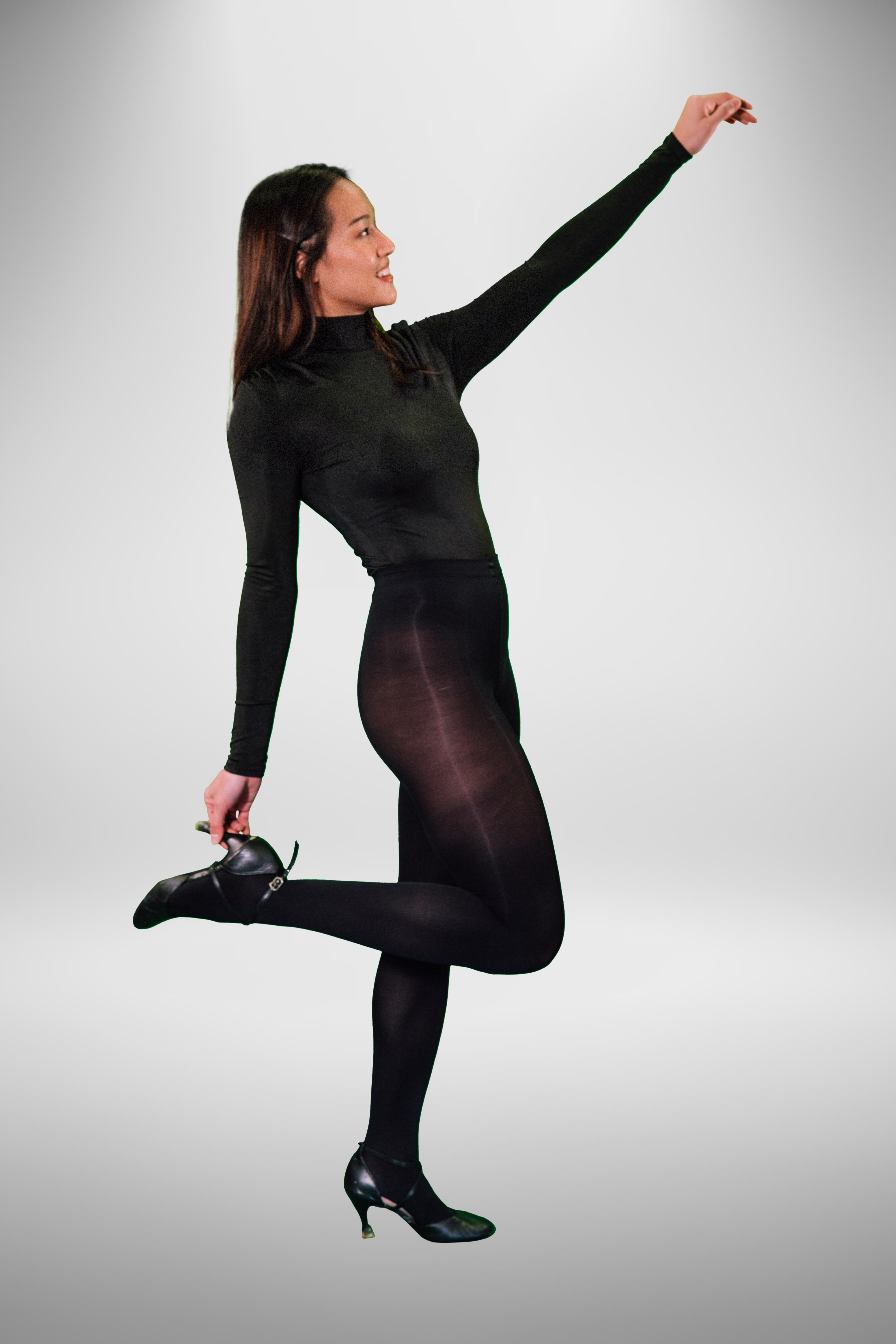 Figure 6: Mimesis of a pose from a fashion spread, “Harlequins, Holly and Hanky-Panky,” in Her World, December 1976, 66.
Figure 6: Mimesis of a pose from a fashion spread, “Harlequins, Holly and Hanky-Panky,” in Her World, December 1976, 66.Even though the Singaporean woman was more visible in the professional realm, she was also expected to be actively engaged in courtship and romance. [34] The performance of more suggestive poses (Figures 2 and 3) demonstrated an increased sexualization of the female body. This was complemented by an increased frequency of posing with men in the fashion pages, role-playing courtship. This demonstrates how it was becoming the fashionable ideal to be openly dating or engaged in heterosexual relations. These women were seen to be taking charge of their romantic relationships. For example, in the June 1976 issue of Her World, Carrie is pictured emerging from a car escorted by her male companion. In the August 1976 issue of Female, Carrie poses with her male counterpart as if they are dancing. Other examples include a party-themed fashion spread in Her World, December 1976, where the model appears to be flirting with her suitor, and similarly, in another spread in the September 1, 1979 issue of Female, the models hold hands and embrace their male companions as they gallivant through the city. When posing with a partner, the female models’ interaction with the male models affected how they each posed. Nonetheless, the female model remains the center of attention and the male model becomes her accessory as a fashionable woman.
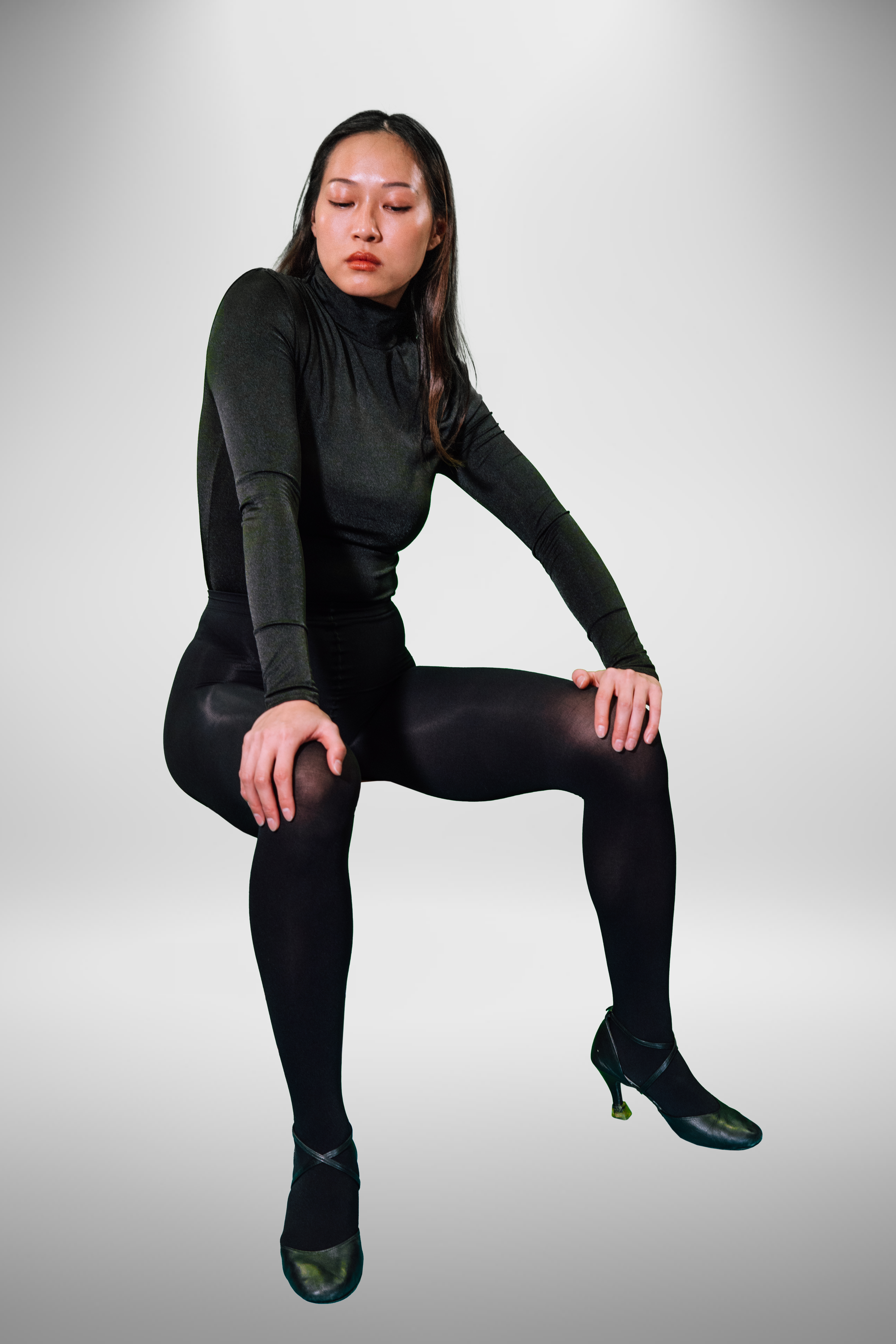
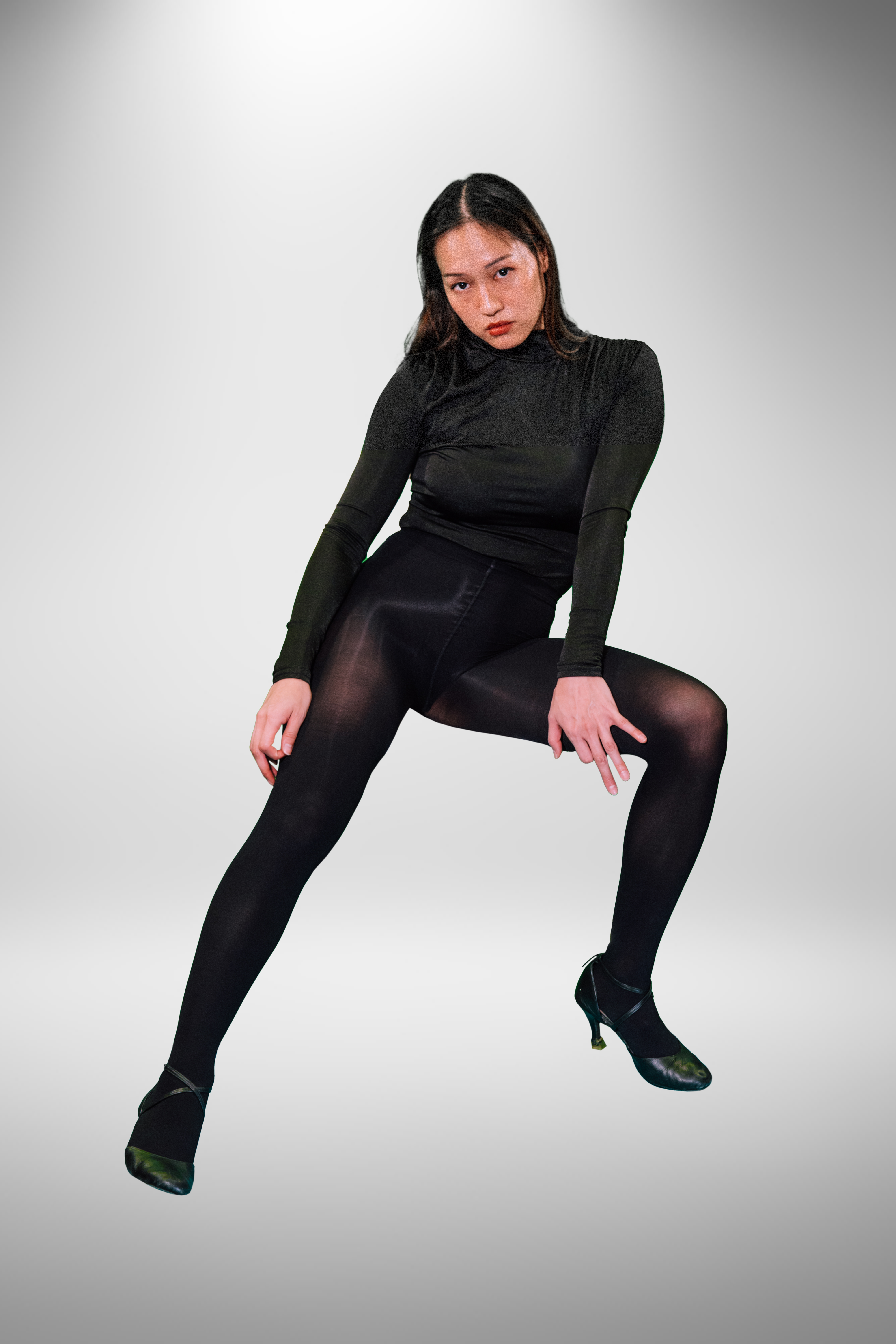
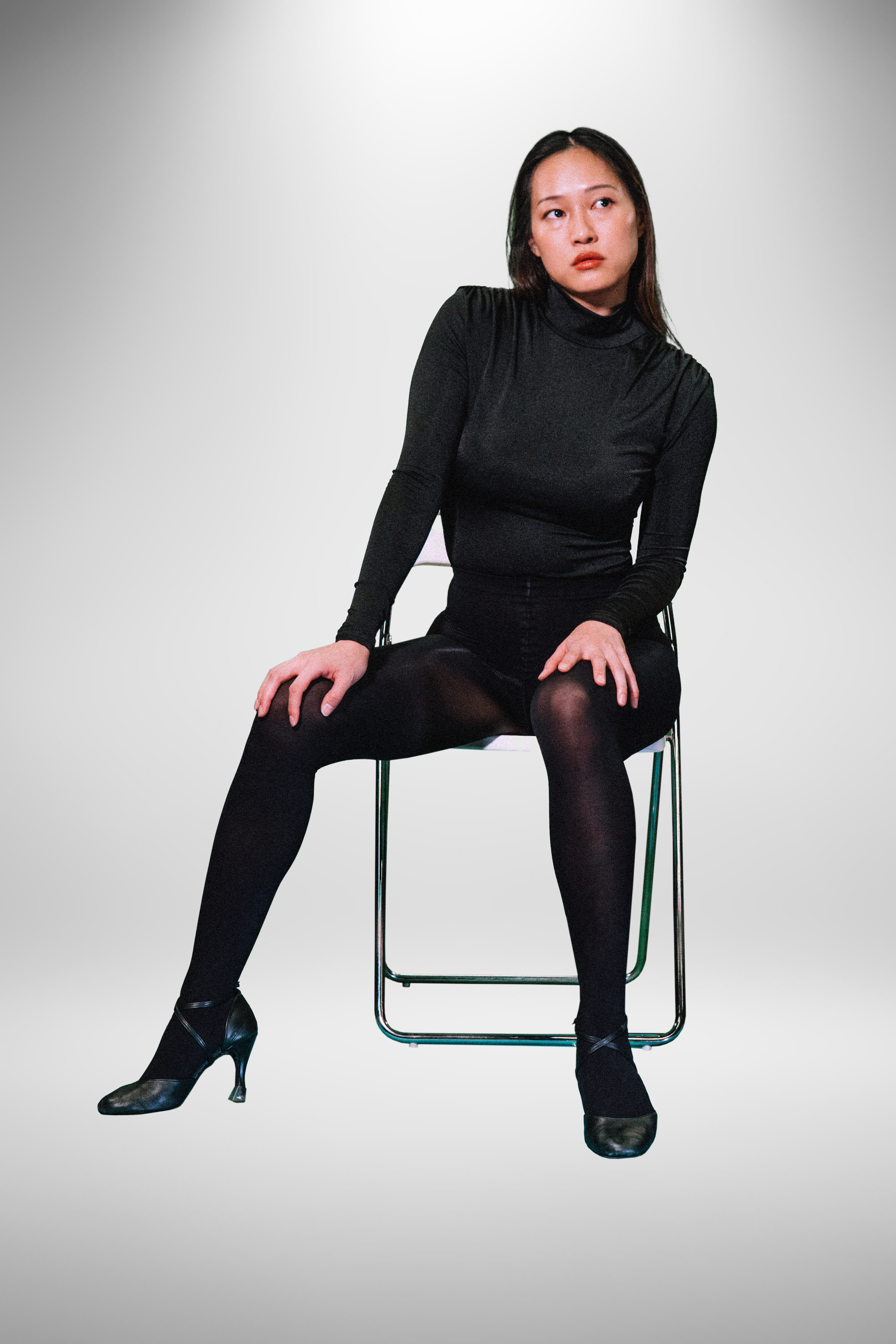 Top: Figure 7: Mimesis of a pose by model Susan in a fashion spread, “Going to Print,” in Her World, July 1977, 40.
Top: Figure 7: Mimesis of a pose by model Susan in a fashion spread, “Going to Print,” in Her World, July 1977, 40.Middle: Figure 8: Mimesis of a pose by model Carrie Wong in a fashion spread, “Re-Orientation,” in Her World, January 1976, 52.
Bottom: Figure 9: Mimesis of a pose by model Carrie Wong in a fashion spread, “TRIMMER, LEANER LINES,” in Female, January 16, 1976, 45.
All images courtesy of the author.
“...the fact that I felt more ‘at home’ in performing these poses speaks to how the 1970s posing practices marked a pivotal transition into embodied performances of 21st-century modernity.”
If the cool demeanor of the Singaporean model is the cornerstone of her progressive identity, it is made even more distinct when performed against the backdrop of the past. In a spread titled “Going to Print” in Her World, July 1977, model Susan posed on-location in what appeared to be a roadside alleyway (Figure 7). In the image, she looks over her shoulder towards an elderly male cobbler squatting against a wall. Her entire posture exudes boredom. The downward gaze with a slightly upward-tilted chin enhances the jawline. The lifted eyebrows and pout with faintly downturned lips create an air of unapproachability. Her hands rest on her knees such that her upper torso leans forward, creating a slight arch in her lower back. Her arms are held away from her torso so that the focal point of her waist is accentuated. Her chest is sunken into her shoulders and her ribcage isolates to the right so that her right shoulder is higher than her left. The shortened distance between the chin and the shoulder has the effect of a defiant attitude. Her legs are spread (despite wearing a long skirt). The slouchy androgynous posture is anything but what is expected of a demure Oriental woman. Instead, Susan appears to defy these conservative expectations. However, when seen in the context of the aged alleyway and cobbler, Susan’s worldliness betrays her localized surroundings. Her modernity is built on the temporal distance between her and her surroundings. The elderly cobbler is used as a foil against the model’s modern blasé attitude. He toils away as she looks on, curious but mainly unbothered.
Similarly, Carrie Wong performs temporal distancing in an image from the spread, “Re-Orientation,” in Her World, January 1976 (Figure 8). Styled in a Chinese-inspired long dress with a mandarin collar and buttons, she sits with a rebellious attitude. Her outfit, accessorized with a rattan-looking bag with shoes to match and pearls, gestures towards Chinese tradition, moreover highlighted by the spread’s title. She sits on an aged wooden bench next to an old tree in a barren garden, with vehicles and an elderly woman in the background. A tin bucket and straw broom rest next to her. Her surroundings imply a casual sense of being in a local and unpretentious neighborhood with people going about their day. The indications of everyday life juxtapose Carrie’s highly stylized pose. She sits with her weight on one hip. Her legs are spread with the right leg outstretched to the camera. She leans exaggeratedly to one side so that her body contracts on the right and her shoulders are asymmetrical in her slouch. She looks up beneath her bangs as if daring the onlooker to look back. In my mimesis, the bold placement of the body required a conscious contraction at an awkward angle in order to achieve the performance of ease. The accentuation of the unnatural asymmetry allowed Carrie to stand out as the fashionable and modern woman against the unassuming backdrop of everyday Singaporean life. Despite her supposed affinity with her environment through her clothing, her posture looks edgy and as a result she is unlike the rustic surroundings.
Carrie is masterful in creating temporal juxtaposition, again showcased in a spread, “TRIMMER, LEANER LINES,” in Female, January 16, 1976 (Figure 9). In the arched Peranakan-style alleyways of what is now preserved as “old” Singapore amidst what seems to be a rattan shop evinced by the rattan baskets hanging from the walls and piled up on the side of the image, Carrie and another model, Perry Pereira, pose in garments akin to the working woman’s uniform of the 1970s. Both of them wear color-blocked looks of calf-length skirts with collared blouses and high heels. Not only do their bright outfits look out of place against the muted background of the old corridor, but the way they pose enhances this difference. Carrie, sitting on a rattan basket, performs similar gestures to her pose in Figure 8—her legs are apart and she leans her body to one side to establish that asymmetry of shoulders. In the background, we see Singaporeans going about their day, unaware that they are framed as the temporal contrast to the modern women in the foreground. Wong’s style of posing—the crunching of the side body, opening of the legs, and haughty expression—successfully set her apart as an edgy young woman. Her lexicon of cool gestures is emblematic of a modernizing Singapore, eager to set itself apart.
In these fashion images, allochronism is at play. [35] Temporal juxtaposition between the old and new demonstrates how nostalgia is harnessed to perform modernity. The fashion images employ nostalgia as a device not only to pay homage to a sense of “authentic” national identity but to also envision modernity. Nostalgia, Svetlana Boym wrote, “is a longing for a home that no longer exists or has never existed. Nostalgia is a sentiment of loss and displacement, but it is also a romance with one’s own fantasy.” [36] In featuring everyday Singapore as the backdrop, the images display a desire for an essence of Singaporeanness. Simultaneously, the positioning of the models—both in the center of the images and in their poses—disavow this authenticity and quite literally push everyday Singapore to the back. The blurry background scenes of everyday Singapore represent a slower pace of life yet unmarred by industrialization. Boym wrote, “The rapid pace of industrialization and modernization increased the intensity of people’s longing for the slower rhythms of the past, for continuity, social cohesion and tradition. Yet this new obsession with the past reveals an abyss of forgetting and takes place in inverse proportion to its actual preservation.” [37] The images are both performative and historical documentation. In the creation of distance between old and new, a national rebranding occurs in the form of the fashion model who presents a more globally ambiguous identity, who looks Asian but is also cosmopolitan and cool. On the other hand, the everyday Singaporean relegated as a background prop represents the temporal other. As Jansen (2020) argued that “coloniality expresses the absenting of the other.” [38] The allochronism here is at the expense of the faceless Singaporean folks, turned into a non-Western spectacle, [39] highlighting that the image’s fashionability leans on coloniality. There is an artificial idea of continuity and social coexistence established through the juxtaposition. What results in the image is a nostalgic displacement; of self-contradiction—“In the moment in which the other is turned into a spectacle she is erased.” [40] The desire to build a home in Singapore is overshadowed by the desire to appear modern and new. It is within this tension that the sensibility of 1970s modern Singapore lay.
Before I conclude, it is worth briefly reflecting on my personal experience of re-enacting the poses. As a contemporary Singaporean woman, I directly inherited the ideals set out by these women on the fashion pages and in magazines that continue to this day and that I habitually read in the past. These fashion editorials have directly influenced Singaporean womanhood, affecting how women today carry themselves in Singaporean society daily. I wrote earlier that the 1970s poses juxtaposed the proper and “pleasant” poses of the mid-1960s and served as a transition into the more experimental, glamorous, and expansive poses of the 1980s. From the hyper-disciplined poses of the mid-1960s, the 1970s poses in their slouchiness and appearance of ease allowed a sense of relaxation, like the models had room to exhale, and that was also a relief to my body. Though the 1970s poses did still contain a sense of restraint as exemplified in the aloof expressions many models adopted, the fact that I felt more “at home” in performing these poses speaks to how the 1970s posing practices marked a pivotal transition into embodied performances of 21st-century modernity.
In this article, I have addressed the development of the fashion modeling industry in Singapore and analyzed the posing techniques behind the persona of the cool girl. I discovered that the turn towards curved lines of the body, in arching the back and in slouching, combined with bored or rebellious expressions, and an overall aura of self-confidence, culminated in how the models performed their modernity. This was heightened when they posed in front of scenes of “Old Singapore” and in work places. This cool feminine persona embodied the aspirations and anxieties about modernization in 1970s Singapore. Coolness, I argue, speaks to what an Orientalist lens would call “cosmopolitan charm.” It is cosmopolitan because it embodies tensions between the creative agency of asserting one’s non-Western identity in relation to globalization and the need to conform to a brand of modernity that is already intelligible in a “global” sense. These play out on the bodies of the models who, through their poses on fashion pages, explored different ways women could aspire to perform in public, professional, and interpersonal realms.
Notes: Cosmopolitan Charm in the Chic Economy
[1] Philip Holden, “Postcolonial desire: Placing Singapore,” Postcolonial Studies 11, no. 3 (2008): 345.
[2] Djurdja Bartlett, “The Politics of Transnational Fashion,” Fashion Theory 26, no. 4 (2022): 458.
[3] A brief version that attends to the 1950s to the 1990s that I wrote has been published on sgfashionhistories.net as part of a project, Singapore Fashion Histories, that was conducted with the support of the National Heritage Board. The article published there was the result of documenting the development of the modeling industry through newspaper broadsheets only.
[4] Boaventura De Sousa Santos, The End of the Cognitive Empire: The Coming of Age of Epistemologies of the South (Durham and London: Duke University Press, 2018).
[5] I wrote a chapter focusing on my methodology, somatic mimesis, in Angelene Wong, “Their Bodies/My Body: Posing The Modern Singaporean Female As Decolonial Method,” in Fashion in Theory: Historicization, Practice and Methodologies, ed. Marco Pecorari (Manchester University Press, forthcoming).
[6] This speaks to larger institutional barriers to disseminating archival material despite the physical access granted to researchers—a paradox that deserves greater discussion elsewhere.
[7] Janine Wookey, “Sex Discrimination S’pore Style,” Her World, April 1978, 17, 24.
[8] Rebecca Chua, “Have Women Libbers Become Bourgeois Pets?” Her World, December 1978, 6-7, 10.
[9] Celia Wong, “GUESS WHO IS IN TOWN,” Female, March 10, 1975, 26-27.
[10] “HONG KONG FASHION FESTIVAL,” Her World, June 1971, 7-12.
[11] Ruth Warner, “My Say,” Her World, August 1976, 9-10.
[12] Betty L. Khoo, “Glamour job for a few years,” New Nation, December 20, 1973, 13. https://eresources.nlb.gov.sg/newspapers/digitised/article/newnation19731220-1.2.38.1.
[13] Jane Chew, “CONTACT,” Her World, June 1975, 41-42.
[14] John De Souza, Cat Ong, and Tom Rao (eds.), Fashion Most Wanted: Singapore's Top Insider Secrets from the Past Five Decades (Singapore: Straits Times Press, 2016), 35-36.
[15] Bartlett, “The Politics of Transnational Fashion,” 458.
[16] Ashley Mears, Pricing Beauty: The Making of a Fashion Model (Berkeley, Los Angeles, and London: University of California Press, 2011), 33.
[17] “MODEL DISCOVERY ‘76: ARE YOU THE GIRL WE ARE LOOKING FOR?” Female, September 1, 1976, 62-63; “Female Model Discovery 1976,” Female, January 1, 1977, 58-59.
[18] “Models on the move to far away places,” The Straits Times, March 21, 1974, 14. https://eresources.nlb.gov.sg/newspapers/digitised/article/straitstimes19740321-1.2.149.
[19] Nancy Byramji, “DEMAND FOR FACTORY GIRLS,” The Straits Times, June 18, 1978, 16. https://eresources.nlb.gov.sg/newspapers/digitised/article/straitstimes19780618-1.2.86.6.
[20] Cynthia Wee, “TOP MODELS OF THE YEAR 1977: Carrie Wong, Tina Tan, Theresa Leu, Jean Ho and Jane Lim lead the field,” Her World, February 1978, 22-25.
[21] Judith Yong, “On our modelling scene … Bodies last longer than faces,” The Straits Times, November 15, 1970, 15, https://eresources.nlb.gov.sg/newspapers/digitised/page/straitstimes19701115-1.1.15; Helen Lee, “Photographers and their models,” Her World, May 1977, 14-15.
[22] Lee Ching Chew, “It takes more than good looks to be a model,” The Straits Times, March 26, 1972, 5. https://eresources.nlb.gov.sg/newspapers/digitised/article/straitstimes19720326-1.2.24.
[23] “Getting to the top in the modelling world is tough - says these four beauties who have made it,” Her World, June 1970, 16-18.
[24] “Getting to the top in the modelling world is tough,” 16-18.
[25] Lucie Wilson, “THE NAME GAME,” Female, November 18, 1974, 8-9.
[26] “LADY ON A MISSION,” New Nation, March 12, 1974, 12. https://eresources.nlb.gov.sg/newspapers/digitised/article/newnation19740312-1.2.38.
[27] “making faces,” Her World, December 1972, 6-8.
[28] Marianne Pereira, “Female COVER STORY: CARRIE WONG,” Female, December 16, 1974, 66-67.
[29] Motti Regev, “Cultural Uniqueness and Aesthetic Cosmopolitanism,” European Journal of Social Theory 10, no. 1 (2007): 135.
[30] Peter N. Stearns, American Cool: Constructing a Twentieth-Century Emotional Style (New York and London: New York University Press, 1994).
[31] Stearns, American Cool, 1 and 310.
[32] Belk, Tian, and Paavola (2010) provide a succinct historical overview of the developments of coolness from thousands of years ago in Africa to contemporary iterations in consumer marketing. See Russell W. Belk, Kelly Tian, and Heli Paavola, “Consuming Cool: Behind the Unemotional Mask,” Research in Consumer Behavior 12 (2010): 183-208. See also Angela McRobbie (ed.), Zoot Suits and Second-hand Dresses: An Anthology of Fashion and Music (Macmillan, 1989); Carol Tulloch and Syd Shelton, The Birth of Cool: Style Narratives of the African Diaspora (Bloomsbury, 2016).
[33] Belk, Tian, and Paavola, “Consuming Cool,” 189.
[34] The greater visibility and fashionability of courtship for women are arguably related to the natal schemes in Singapore at that time. Following the postwar economic boom, the Singapore Family Planning and Population Board (SFPPB) was established in 1966 to oversee Singapore’s family planning and control the growing population. Campaigns encouraged families to limit themselves to two children, legalizing sterilization in 1970. Abortion was also legalized in 1969 and then more accessible in 1974 with the Abortion Act. The measures resulted in the fertility rate dropping to replacement level in 1975, with the birth rate decreasing from 29.5 per thousand to 17.1 from 1966 to 1983. The success was so much so that in the early 1980s, there were attempts to reverse this downward trend by encouraging educated mothers to have children. Information is cited from Andrea Kee, “The Early Days of Family Planning in Singapore,” BiblioAsia.https://biblioasia.nlb.gov.sg/vol-18/issue-3/oct-dec-2022/family-planning-singapore/. Improved access to birth control, enhanced education, and greater career ambitions have arguably shaped the modern image of the fashionable Singaporean woman, who enjoys the freedom to pursue romantic interests as she chooses.
[35] Chronopolitics, Aurélie Van de Peer argued,, is the central logic of fashion: “If it were not for the devaluation of the past and the exaltation of the present and the changeable, fashion would not have existed.” Fashion’s ability to mark its ever-presentness is based on the concept of time as linear, established through modernity. Van de Peer adopted Johannes Fabian’s (2002) idea of “denial of coevalness” that sets up the “creation of the Other as an ‘allochronism’” that “supports the political project of the non-inclusion of the Other in the present” The establishment of fashionability through chronopolitics and trends trickling down the global fashion system thus perpetuates existing global hierarchies that cast fashion’s Other into the past. See Aurélie Van de Peer, “So Last Season: The Production of the Fashion Present in the Politics of Time,” Fashion Theory 18, no. 3 (2014): 322, 327.
[36] Svetlana Boym, The Future of Nostalgia (New York: Basic Books, 2001), XIV.
[37] Boym, The Future of Nostalgia, 16.
[38] M. Angela Jansen, “Fashion and the Phantasmagoria of Modernity: An Introduction to Decolonial Fashion Discourse,” Fashion Theory 24, no. 6 (2020): 37.
[39] Rolando Vázquez, “Modernity, the Greatest Show on Earth: Thoughts on Visibility,” Borderlands 9, no. 2 (2010).
[40] Vázquez, “Modernity.”
Similarly, Carrie Wong performs temporal distancing in an image from the spread, “Re-Orientation,” in Her World, January 1976 (Figure 8). Styled in a Chinese-inspired long dress with a mandarin collar and buttons, she sits with a rebellious attitude. Her outfit, accessorized with a rattan-looking bag with shoes to match and pearls, gestures towards Chinese tradition, moreover highlighted by the spread’s title. She sits on an aged wooden bench next to an old tree in a barren garden, with vehicles and an elderly woman in the background. A tin bucket and straw broom rest next to her. Her surroundings imply a casual sense of being in a local and unpretentious neighborhood with people going about their day. The indications of everyday life juxtapose Carrie’s highly stylized pose. She sits with her weight on one hip. Her legs are spread with the right leg outstretched to the camera. She leans exaggeratedly to one side so that her body contracts on the right and her shoulders are asymmetrical in her slouch. She looks up beneath her bangs as if daring the onlooker to look back. In my mimesis, the bold placement of the body required a conscious contraction at an awkward angle in order to achieve the performance of ease. The accentuation of the unnatural asymmetry allowed Carrie to stand out as the fashionable and modern woman against the unassuming backdrop of everyday Singaporean life. Despite her supposed affinity with her environment through her clothing, her posture looks edgy and as a result she is unlike the rustic surroundings.
Carrie is masterful in creating temporal juxtaposition, again showcased in a spread, “TRIMMER, LEANER LINES,” in Female, January 16, 1976 (Figure 9). In the arched Peranakan-style alleyways of what is now preserved as “old” Singapore amidst what seems to be a rattan shop evinced by the rattan baskets hanging from the walls and piled up on the side of the image, Carrie and another model, Perry Pereira, pose in garments akin to the working woman’s uniform of the 1970s. Both of them wear color-blocked looks of calf-length skirts with collared blouses and high heels. Not only do their bright outfits look out of place against the muted background of the old corridor, but the way they pose enhances this difference. Carrie, sitting on a rattan basket, performs similar gestures to her pose in Figure 8—her legs are apart and she leans her body to one side to establish that asymmetry of shoulders. In the background, we see Singaporeans going about their day, unaware that they are framed as the temporal contrast to the modern women in the foreground. Wong’s style of posing—the crunching of the side body, opening of the legs, and haughty expression—successfully set her apart as an edgy young woman. Her lexicon of cool gestures is emblematic of a modernizing Singapore, eager to set itself apart.
In these fashion images, allochronism is at play. [35] Temporal juxtaposition between the old and new demonstrates how nostalgia is harnessed to perform modernity. The fashion images employ nostalgia as a device not only to pay homage to a sense of “authentic” national identity but to also envision modernity. Nostalgia, Svetlana Boym wrote, “is a longing for a home that no longer exists or has never existed. Nostalgia is a sentiment of loss and displacement, but it is also a romance with one’s own fantasy.” [36] In featuring everyday Singapore as the backdrop, the images display a desire for an essence of Singaporeanness. Simultaneously, the positioning of the models—both in the center of the images and in their poses—disavow this authenticity and quite literally push everyday Singapore to the back. The blurry background scenes of everyday Singapore represent a slower pace of life yet unmarred by industrialization. Boym wrote, “The rapid pace of industrialization and modernization increased the intensity of people’s longing for the slower rhythms of the past, for continuity, social cohesion and tradition. Yet this new obsession with the past reveals an abyss of forgetting and takes place in inverse proportion to its actual preservation.” [37] The images are both performative and historical documentation. In the creation of distance between old and new, a national rebranding occurs in the form of the fashion model who presents a more globally ambiguous identity, who looks Asian but is also cosmopolitan and cool. On the other hand, the everyday Singaporean relegated as a background prop represents the temporal other. As Jansen (2020) argued that “coloniality expresses the absenting of the other.” [38] The allochronism here is at the expense of the faceless Singaporean folks, turned into a non-Western spectacle, [39] highlighting that the image’s fashionability leans on coloniality. There is an artificial idea of continuity and social coexistence established through the juxtaposition. What results in the image is a nostalgic displacement; of self-contradiction—“In the moment in which the other is turned into a spectacle she is erased.” [40] The desire to build a home in Singapore is overshadowed by the desire to appear modern and new. It is within this tension that the sensibility of 1970s modern Singapore lay.
Conclusion
Before I conclude, it is worth briefly reflecting on my personal experience of re-enacting the poses. As a contemporary Singaporean woman, I directly inherited the ideals set out by these women on the fashion pages and in magazines that continue to this day and that I habitually read in the past. These fashion editorials have directly influenced Singaporean womanhood, affecting how women today carry themselves in Singaporean society daily. I wrote earlier that the 1970s poses juxtaposed the proper and “pleasant” poses of the mid-1960s and served as a transition into the more experimental, glamorous, and expansive poses of the 1980s. From the hyper-disciplined poses of the mid-1960s, the 1970s poses in their slouchiness and appearance of ease allowed a sense of relaxation, like the models had room to exhale, and that was also a relief to my body. Though the 1970s poses did still contain a sense of restraint as exemplified in the aloof expressions many models adopted, the fact that I felt more “at home” in performing these poses speaks to how the 1970s posing practices marked a pivotal transition into embodied performances of 21st-century modernity.
In this article, I have addressed the development of the fashion modeling industry in Singapore and analyzed the posing techniques behind the persona of the cool girl. I discovered that the turn towards curved lines of the body, in arching the back and in slouching, combined with bored or rebellious expressions, and an overall aura of self-confidence, culminated in how the models performed their modernity. This was heightened when they posed in front of scenes of “Old Singapore” and in work places. This cool feminine persona embodied the aspirations and anxieties about modernization in 1970s Singapore. Coolness, I argue, speaks to what an Orientalist lens would call “cosmopolitan charm.” It is cosmopolitan because it embodies tensions between the creative agency of asserting one’s non-Western identity in relation to globalization and the need to conform to a brand of modernity that is already intelligible in a “global” sense. These play out on the bodies of the models who, through their poses on fashion pages, explored different ways women could aspire to perform in public, professional, and interpersonal realms.
Notes: Cosmopolitan Charm in the Chic Economy
[1] Philip Holden, “Postcolonial desire: Placing Singapore,” Postcolonial Studies 11, no. 3 (2008): 345.
[2] Djurdja Bartlett, “The Politics of Transnational Fashion,” Fashion Theory 26, no. 4 (2022): 458.
[3] A brief version that attends to the 1950s to the 1990s that I wrote has been published on sgfashionhistories.net as part of a project, Singapore Fashion Histories, that was conducted with the support of the National Heritage Board. The article published there was the result of documenting the development of the modeling industry through newspaper broadsheets only.
[4] Boaventura De Sousa Santos, The End of the Cognitive Empire: The Coming of Age of Epistemologies of the South (Durham and London: Duke University Press, 2018).
[5] I wrote a chapter focusing on my methodology, somatic mimesis, in Angelene Wong, “Their Bodies/My Body: Posing The Modern Singaporean Female As Decolonial Method,” in Fashion in Theory: Historicization, Practice and Methodologies, ed. Marco Pecorari (Manchester University Press, forthcoming).
[6] This speaks to larger institutional barriers to disseminating archival material despite the physical access granted to researchers—a paradox that deserves greater discussion elsewhere.
[7] Janine Wookey, “Sex Discrimination S’pore Style,” Her World, April 1978, 17, 24.
[8] Rebecca Chua, “Have Women Libbers Become Bourgeois Pets?” Her World, December 1978, 6-7, 10.
[9] Celia Wong, “GUESS WHO IS IN TOWN,” Female, March 10, 1975, 26-27.
[10] “HONG KONG FASHION FESTIVAL,” Her World, June 1971, 7-12.
[11] Ruth Warner, “My Say,” Her World, August 1976, 9-10.
[12] Betty L. Khoo, “Glamour job for a few years,” New Nation, December 20, 1973, 13. https://eresources.nlb.gov.sg/newspapers/digitised/article/newnation19731220-1.2.38.1.
[13] Jane Chew, “CONTACT,” Her World, June 1975, 41-42.
[14] John De Souza, Cat Ong, and Tom Rao (eds.), Fashion Most Wanted: Singapore's Top Insider Secrets from the Past Five Decades (Singapore: Straits Times Press, 2016), 35-36.
[15] Bartlett, “The Politics of Transnational Fashion,” 458.
[16] Ashley Mears, Pricing Beauty: The Making of a Fashion Model (Berkeley, Los Angeles, and London: University of California Press, 2011), 33.
[17] “MODEL DISCOVERY ‘76: ARE YOU THE GIRL WE ARE LOOKING FOR?” Female, September 1, 1976, 62-63; “Female Model Discovery 1976,” Female, January 1, 1977, 58-59.
[18] “Models on the move to far away places,” The Straits Times, March 21, 1974, 14. https://eresources.nlb.gov.sg/newspapers/digitised/article/straitstimes19740321-1.2.149.
[19] Nancy Byramji, “DEMAND FOR FACTORY GIRLS,” The Straits Times, June 18, 1978, 16. https://eresources.nlb.gov.sg/newspapers/digitised/article/straitstimes19780618-1.2.86.6.
[20] Cynthia Wee, “TOP MODELS OF THE YEAR 1977: Carrie Wong, Tina Tan, Theresa Leu, Jean Ho and Jane Lim lead the field,” Her World, February 1978, 22-25.
[21] Judith Yong, “On our modelling scene … Bodies last longer than faces,” The Straits Times, November 15, 1970, 15, https://eresources.nlb.gov.sg/newspapers/digitised/page/straitstimes19701115-1.1.15; Helen Lee, “Photographers and their models,” Her World, May 1977, 14-15.
[22] Lee Ching Chew, “It takes more than good looks to be a model,” The Straits Times, March 26, 1972, 5. https://eresources.nlb.gov.sg/newspapers/digitised/article/straitstimes19720326-1.2.24.
[23] “Getting to the top in the modelling world is tough - says these four beauties who have made it,” Her World, June 1970, 16-18.
[24] “Getting to the top in the modelling world is tough,” 16-18.
[25] Lucie Wilson, “THE NAME GAME,” Female, November 18, 1974, 8-9.
[26] “LADY ON A MISSION,” New Nation, March 12, 1974, 12. https://eresources.nlb.gov.sg/newspapers/digitised/article/newnation19740312-1.2.38.
[27] “making faces,” Her World, December 1972, 6-8.
[28] Marianne Pereira, “Female COVER STORY: CARRIE WONG,” Female, December 16, 1974, 66-67.
[29] Motti Regev, “Cultural Uniqueness and Aesthetic Cosmopolitanism,” European Journal of Social Theory 10, no. 1 (2007): 135.
[30] Peter N. Stearns, American Cool: Constructing a Twentieth-Century Emotional Style (New York and London: New York University Press, 1994).
[31] Stearns, American Cool, 1 and 310.
[32] Belk, Tian, and Paavola (2010) provide a succinct historical overview of the developments of coolness from thousands of years ago in Africa to contemporary iterations in consumer marketing. See Russell W. Belk, Kelly Tian, and Heli Paavola, “Consuming Cool: Behind the Unemotional Mask,” Research in Consumer Behavior 12 (2010): 183-208. See also Angela McRobbie (ed.), Zoot Suits and Second-hand Dresses: An Anthology of Fashion and Music (Macmillan, 1989); Carol Tulloch and Syd Shelton, The Birth of Cool: Style Narratives of the African Diaspora (Bloomsbury, 2016).
[33] Belk, Tian, and Paavola, “Consuming Cool,” 189.
[34] The greater visibility and fashionability of courtship for women are arguably related to the natal schemes in Singapore at that time. Following the postwar economic boom, the Singapore Family Planning and Population Board (SFPPB) was established in 1966 to oversee Singapore’s family planning and control the growing population. Campaigns encouraged families to limit themselves to two children, legalizing sterilization in 1970. Abortion was also legalized in 1969 and then more accessible in 1974 with the Abortion Act. The measures resulted in the fertility rate dropping to replacement level in 1975, with the birth rate decreasing from 29.5 per thousand to 17.1 from 1966 to 1983. The success was so much so that in the early 1980s, there were attempts to reverse this downward trend by encouraging educated mothers to have children. Information is cited from Andrea Kee, “The Early Days of Family Planning in Singapore,” BiblioAsia.https://biblioasia.nlb.gov.sg/vol-18/issue-3/oct-dec-2022/family-planning-singapore/. Improved access to birth control, enhanced education, and greater career ambitions have arguably shaped the modern image of the fashionable Singaporean woman, who enjoys the freedom to pursue romantic interests as she chooses.
[35] Chronopolitics, Aurélie Van de Peer argued,, is the central logic of fashion: “If it were not for the devaluation of the past and the exaltation of the present and the changeable, fashion would not have existed.” Fashion’s ability to mark its ever-presentness is based on the concept of time as linear, established through modernity. Van de Peer adopted Johannes Fabian’s (2002) idea of “denial of coevalness” that sets up the “creation of the Other as an ‘allochronism’” that “supports the political project of the non-inclusion of the Other in the present” The establishment of fashionability through chronopolitics and trends trickling down the global fashion system thus perpetuates existing global hierarchies that cast fashion’s Other into the past. See Aurélie Van de Peer, “So Last Season: The Production of the Fashion Present in the Politics of Time,” Fashion Theory 18, no. 3 (2014): 322, 327.
[36] Svetlana Boym, The Future of Nostalgia (New York: Basic Books, 2001), XIV.
[37] Boym, The Future of Nostalgia, 16.
[38] M. Angela Jansen, “Fashion and the Phantasmagoria of Modernity: An Introduction to Decolonial Fashion Discourse,” Fashion Theory 24, no. 6 (2020): 37.
[39] Rolando Vázquez, “Modernity, the Greatest Show on Earth: Thoughts on Visibility,” Borderlands 9, no. 2 (2010).
[40] Vázquez, “Modernity.”
Issue 15 ︎︎︎
Fashion & Southeast Asia
Issue 14 ︎︎︎
Barbie
Issue 13 ︎︎︎ Fashion & Politics
Issue 13 ︎︎︎ Fashion & Politics

